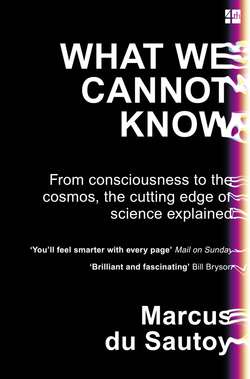Читать книгу What We Cannot Know: Explorations at the Edge of Knowledge - Marcus Sautoy du - Страница 37
KNOWING MY DICE
ОглавлениеA Polish research team has recently analysed the throw of a dice mathematically, and by combining this with the use of high-speed cameras they have revealed that my dice may not be as chaotic and unpredictable as I first feared. The research group consists of father-and-son team Tomasz and Marcin Kapitaniak together with Jaroslaw Strzalko and Juliusz Grabski, and they are based in Lódź. In their paper in the journal Chaos, published in 2012, the team draw similar pictures to those for the magnetic pendulum, but the starting positions are more involved than just two coordinates because they have to give a description of the angle at which the cube is launched and also the speed. The dice will be predictable if for most points in this picture when I alter the starting conditions a little the dice ends up falling on the same side. I can think of the picture being coloured by six colours corresponding to the six sides of the dice. The picture is fractal if however much I zoom in on the shape I still see regions containing at least two colours. The dice is predictable if I don’t see this fractal quality.
The model the Polish team considered assumes the dice is perfectly balanced like the dice I brought back from Vegas. Air resistance, it turns out, can be ignored as it has very little influence on the dice as it tumbles through the air. When the dice hits the table a certain proportion of the dice’s energy is dissipated, so that after sufficiently many bounces the dice has lost all kinetic energy and comes to rest.
Friction on the table is also key, as the dice is likely to slide in the first few bounces but won’t slide in later bounces. However, the model explored by the Polish team assumed a frictionless surface as the dynamics get too complicated to handle when friction is present. So imagine throwing the dice onto an ice rink.
I’d already written down equations based on Newton’s laws of motion for the dynamics of the dice as it flies through the air. In the hands of the Polish team they turn out not to be too complicated. It is the equations for the change in dynamics after the impact with the table that are pretty frightening, taking up ten lines of the paper they wrote.
They discovered that if the amount of energy dissipated on impact with the table is quite high, the picture of the outcome of the dice does not have a fractal quality. This means that if one can settle the initial conditions with appropriate accuracy, the outcome of the throw of my dice is predictable and repeatable. This predictability implies that, more often than not, the dice will land on the face that was lowest when the dice is launched. A dice that is fair when static may actually be biased when one adds in its dynamics.
But as the table becomes more rigid, resulting in less energy being dissipated and hence the dice bouncing more, I start to see a fractal quality emerging.
Moving from (a) to (d), the table dissipates less energy, resulting in a more fractal quality for the outcome of the dice.
This picture looks at varying two parameters: the height from which the dice is launched and variations in the angular velocity around one of the axes. The less energy that is dissipated on impact with the table, the more chaotic its resulting behaviour and the more it seems that the outcome of my dice recedes back into the hands of the gods.
